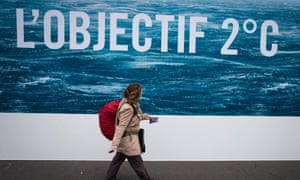Extract from The Guardian
As the most important climate change event ever
enters the final stages, get up to speed on the key points with our
updated guide
The Paris summit aims to secure a deal on cutting
global emissions to limit global warming to 2C. Photograph: Ian
Langsdon/EPA
Saturday 12 December 2015 02.15 AEDT
What is the summit about?
Reaching a new global deal on cutting carbon
emissions beyond 2020 and agreeing financing to help poorer countries
cope with climate change.
When and where is it?
Paris’s north-eastern suburb of Le
Bourget, from 30 November to 11 December (although the French
have said the talks
will run over into the weekend).
Who’s going?
195
countries are attending, and about
150 world leaders including US president Barack Obama, China’s
Xi Jinping, India’s prime minister Narendra Modi and the UK’s
David Cameron attended the opening of the summit.
Will it make a difference to my life?
Yes – but not immediately. The long-term
decisions that governments and businesses take because of a deal in
Paris will
affect everything from which power plants provide your energy to what
food you eat and how likely your home is to flood or be hit by
extreme weather in the future.
Don’t we already have a climate deal?
The Kyoto protocol, the world’s only legally
binding international climate treaty, initially
covered only developed countries, and now covers just the EU,
Australia and a handful of other countries who are required to cut
emissions by 2020. There’s also a
separate, non-binding declaration that covers voluntary cuts by
scores of countries, rich and poor, up to 2020.
What effect have the terror attacks had?
Security was tightened following the attacks, and
planned side events, such as a huge march in Paris, did
not go ahead. Some observers say
the attacks may galvanise greater urgency and solidarity.
What’s the mood music like for a deal?
Hopeful, with caveats. China’s
chief negotiator and the
president of last year’s summit in Lima are among those who say
the political will finally exists for a deal.
But ...?
There are still some significant
sticking points. Some of these appeared to have been resolved by
Friday, the final scheduled day of the talks, but some tricky issues
remained for negotiators to resolve. These include disagreements over
finance from rich countries to help poorer countries adapt to climate
change; how CO2 reductions should be accounted for and whether
different rules should apply to rich and poor nations; and the issue
of whether there will be language in the agreement that refers to
liability or compensation for loss and damage suffered by some
countries due to climate changes.
How do the countries line up?
The world’s two biggest emitters, China and the
US, are both supportive of a deal in Paris – a key difference from
the last big climate summit in 2009, when
China was seen by many as a wrecker. The third-biggest emitter,
India, has been more robust about elements of the proposed deal which
it feels are being unfairly applied to it. India and other developing
countries say their future growth could be curbed by the wrong kind
of deal because of a problem that the rich nations created.
What was agreed before the talks even started?
More than 180 countries – representing
virtually all of the world’s emissions – have submitted their
climate pledges to the UN. But those pledges would still see the
world warm by 2.7-3.3C, according
to analyses. That’s far more than the 2C world
leaders have agreed to hold temperature rises to, which is why
many
countries want to see a mechanism that reviews them every five years.
Won’t the summit have a huge carbon footprint?
The UN
says the conference will result in around 21,000 tonnes CO2
equivalent. The organisers are offsetting the emissions.
Where can I find out more about the background to Paris?
Our in-depth
guide shows how we got here via two decades of climate talks.

No comments:
Post a Comment